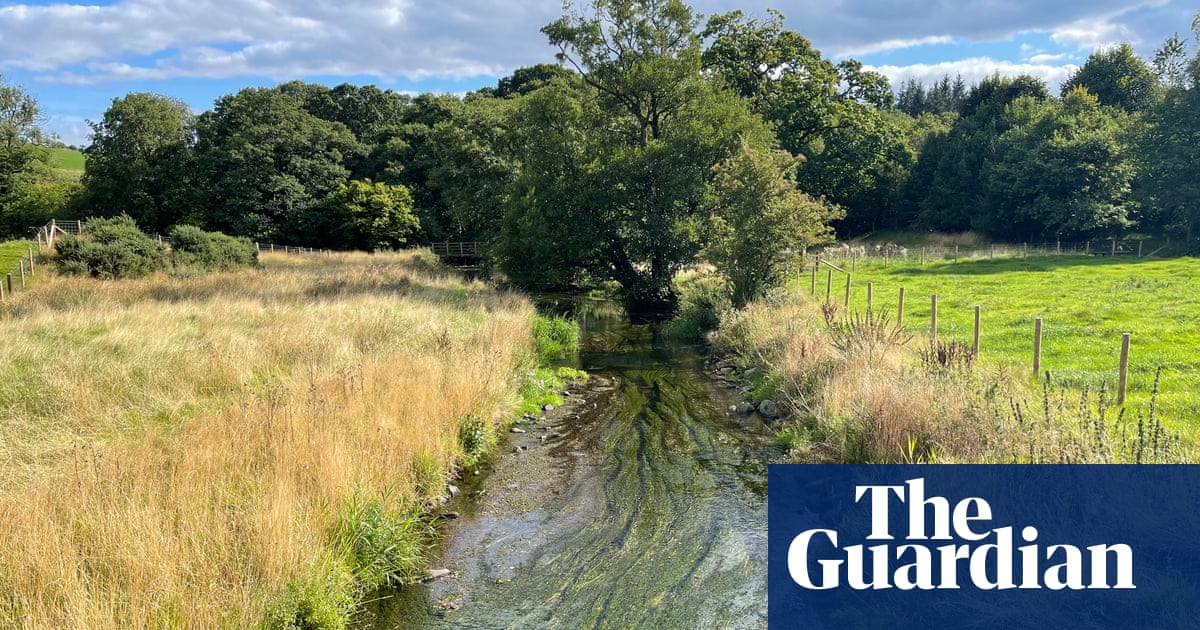
The streams, or becks, that run through James Robinson’s Lake District farm used to be cleaned out regularly – with vegetation yanked out and riverbeds dredged, or even completely filled in.
“The becks on our farm have suffered from overmanagement. We’ve got these elevated becks on some of our farm as well as some that have been cleaned up and cleaned out – it’s been a bit rubbish for ecology and for flood management,” he says now.
His family had run the farm for generations, but Robinson was already rethinking the way that things had been done, and had taken the farm organic 20 years earlier. And as flooding started to hit the farm more frequently, he began to wonder if changes could be made to the landscape that could make it more resilient.
He started by making the area around the becks wilder, cleaning them up less, as well as making them larger so they held more water and protected the rest of the farm from floods. “What we’ve done is a bit of ‘beck wiggling’,” he says. “The beck initially went down in straight lines that have been straightened hundreds of years ago. But we’ve created scrapes [shallow pools] and created pond areas.”
The farmland had tended to go right up to the edge of the waterways, and that was another practice Robinson needed to change: “We fenced off a lot of becks from grazing, to help the vegetation growth come back.” Since leaving the sides of the banks to grow, he has started to see forest regeneration, which helps nature as well as averting floods.
He has also planted trees, to hold more water and improve the soil. “We’ve done a lot of planting. We planted about 10 acres [4 hectares] of our pasture last year, and that will benefit the cattle for shade. We are going to get increased temperatures in coming years so cattle are going to need a lot more shade.”
As floods hit the UK and the rest of the world with growing frequency, “natural flood management” (NFM) is increasingly becoming part of the response. Much of the research in this area is in its relative infancy, and a lot of it is UK-based – partly because of the impact floods have on such a densely populated and heavily built-up country.
The Nature Friendly Farming Network – set up as a way for agricultural businesses to share knowledge about nature-friendly farming and holistic climate strategies – has been a central locus for this work, and farmers are joining in increasing numbers. The NFFN also helps farmers sign up to the various UK government environmental farming schemes, so they can receive grants for their work.
NFM involves practices such as river restoration, where rivers are returned to their natural wiggly shape rather than the straight lines that were created to make navigation easier when boats were used to transport goods around the country. Another tactic is creating floodplains, and reconnecting rivers to them, so that water stays on the plain when there is heavy rain rather than reaching populated areas. Trees are also being planted near waterways, as they can suck up excess moisture and reduce flooding.
More research needs to be done, according to the British Geological Survey: work by the University of Exeter in 2021 found that though the idea of flood management is becoming more popular, “it lacks an established evidence base of flood risk parameters”, and warned: “This lack of evidence base can limit the uptake of NFM as a flood management method.”
But the evidence so far available suggests that NFM works, and also has benefits for the wildlife which lives in the wetlands created by the schemes. The British Geological Survey says more research needs to be done because “understanding how water is stored and released within catchments is vital for predicting the effects of these changes on both floods and droughts, as well as a host of other co-benefits such as biodiversity and agricultural productivity”.
The UK government has found that restoring wetlands has significant carbon sequestration benefits. Flooding costs the UK economy more than £1bn annually – a figure that rises to nearer £5bn in a bad year – and it is likely to get worse in future. And the European Environment Agency is also looking at NFM, after devastating floods in countries including Greece, Italy, Germany and Spain, which have hit agricultural land and town centres as well as claiming lives. They argue that NFM is “more cost-efficient and provides improved infrastructure solutions”.
Samantha Kenyon has had great results from the work she has done so far. She farms livestock on 65 hectares (160 acres) in the lowlands of Wales – just 30 metres above sea level and right next to the River Elwy, which floods frequently, putting her livelihood in peril.
“In 2020, we had three big floods in just two months,” she says. “I asked the Welsh government for help but I quickly realised no one was coming to save us. I had to start figuring it out myself.”
The soil was being drained away, and the water was eating away at the edges of her fields. She tried planting willow saplings on the edge of the river, but when it flooded they were washed away. So Kenyon tried something new. “I started coppicing willow trees from around the farm and burying them in the banks, so they would act as root balls for fresh new growth for saplings. So we created what looked a bit like a graveyard for willow trees.”
The roots of the trees hold the soil together next to the bank, so the soil does not get washed away and the riverbank holds its shape. “It’s now really green and lush around the riverbank. We didn’t do any planting of new seeds – the seed bank was in the trunks of the willow trees already,” she says. “The natural regeneration we’ve had has been amazing.”
Like Robinson, she has fenced off her livestock – sheep and goats – so they don’t touch the area around the riverbank. Though Kenyon is quite early in her journey to save her farm from the river, she has seen great results.
Meanwhile, Robinson can testify to the powerful benefits that these projects have for wildlife. Within a week of finishing the new pond areas, three different species of dragonflies had come to the shallow waters.
“The amount of life that has come is absolutely phenomenal,” he says. “We get the extra bird life as well – we’ve got summer nesting snipe. It’s now a fantastic area where there’s always water, there’s always standing water, even when it’s really, really dry.”
As a child he played in the becks, and thinks he would have been amazed at the wildlife which has come since he started making his farm wilder.
Showing a picture of the bank when he was a child, alongside a recent photo of an otter next to the beck, he says: “That there is an otter next to where that little boy was stood – there was a mother and a young otter catching a crayfish – there is some pretty amazing stuff now happening in that beck, and it’s happening because of better management of waterways. If farmers can clean things up to allow things like otters to thrive, then that would be pretty amazing.”












